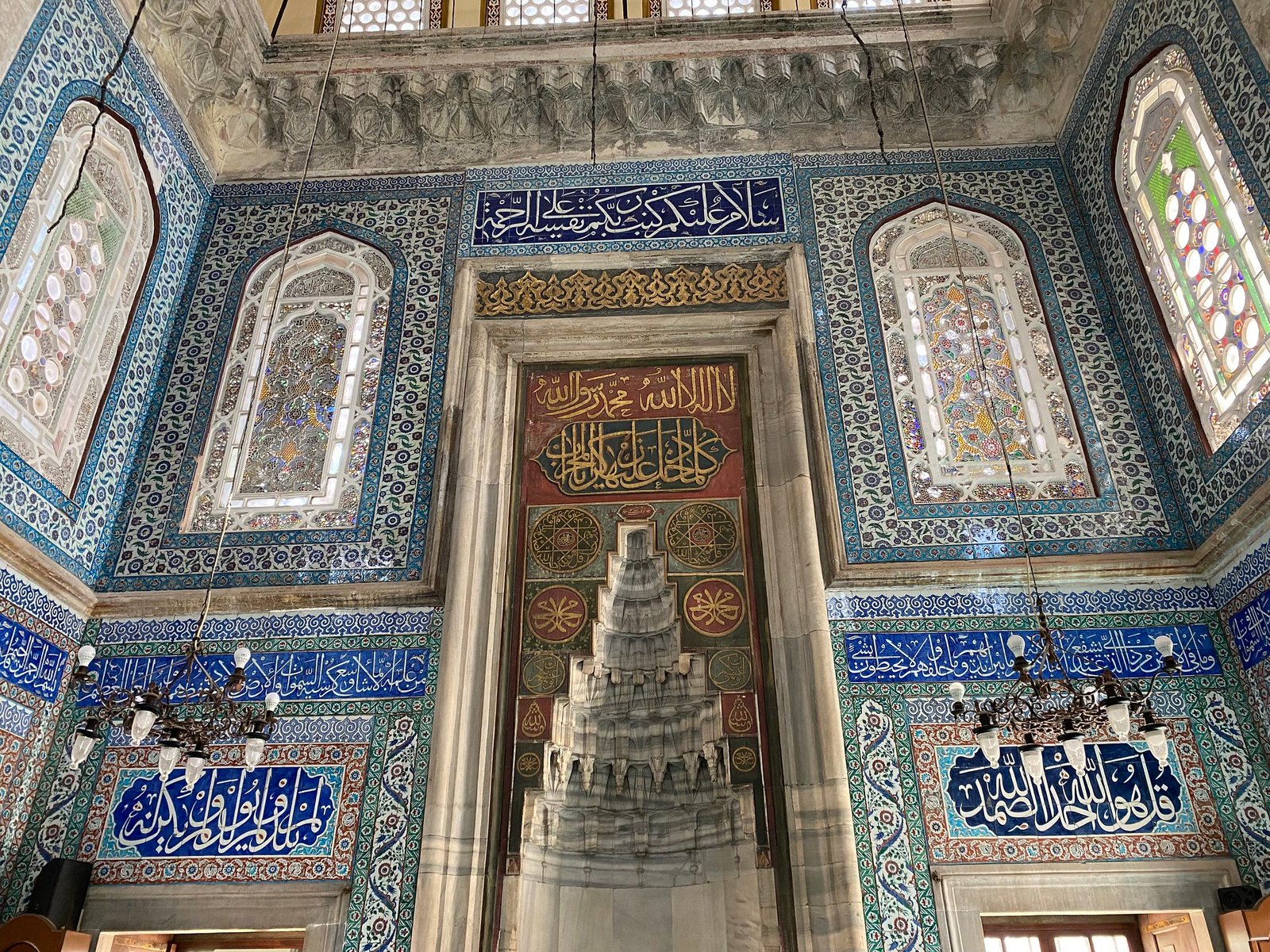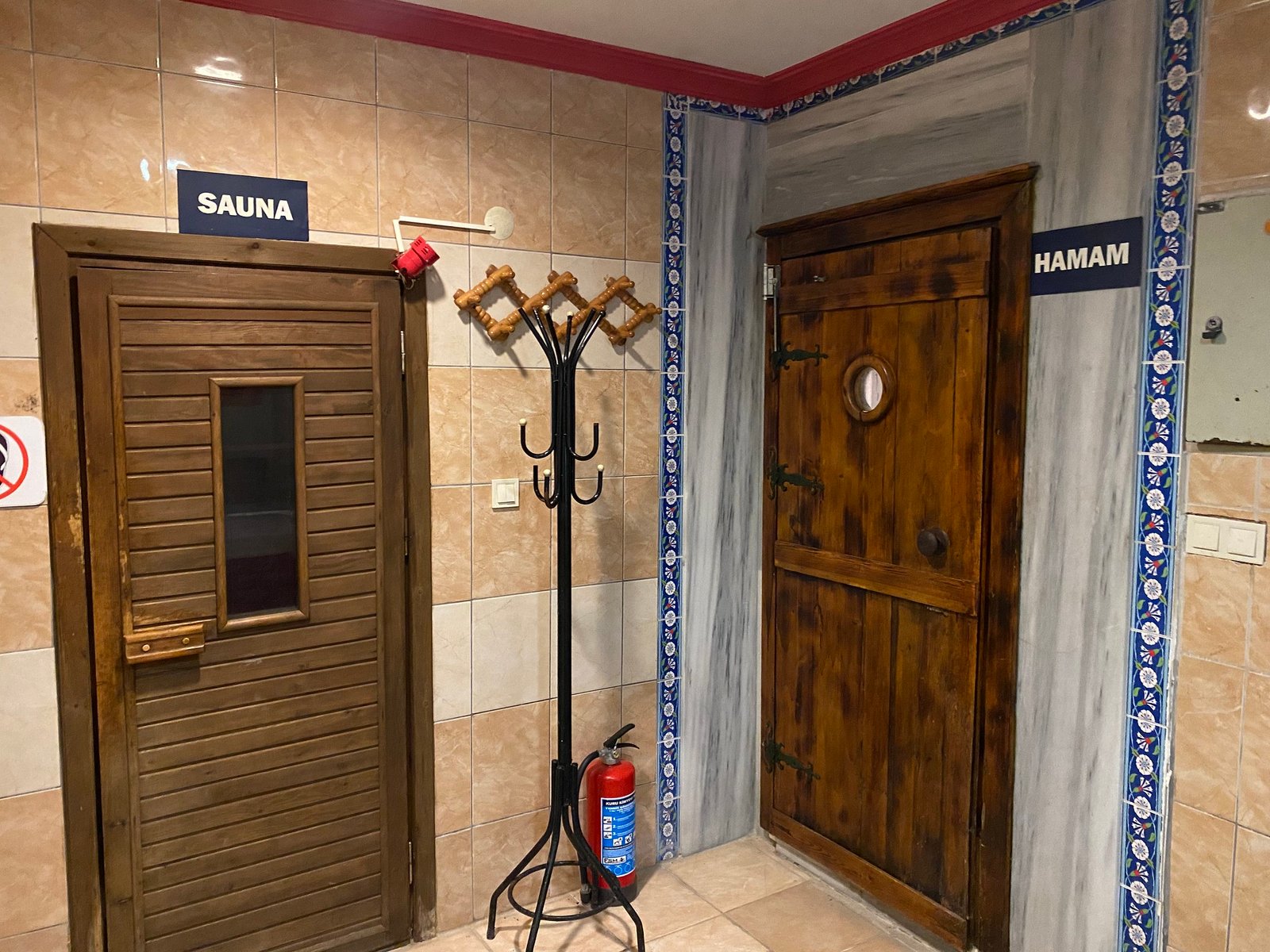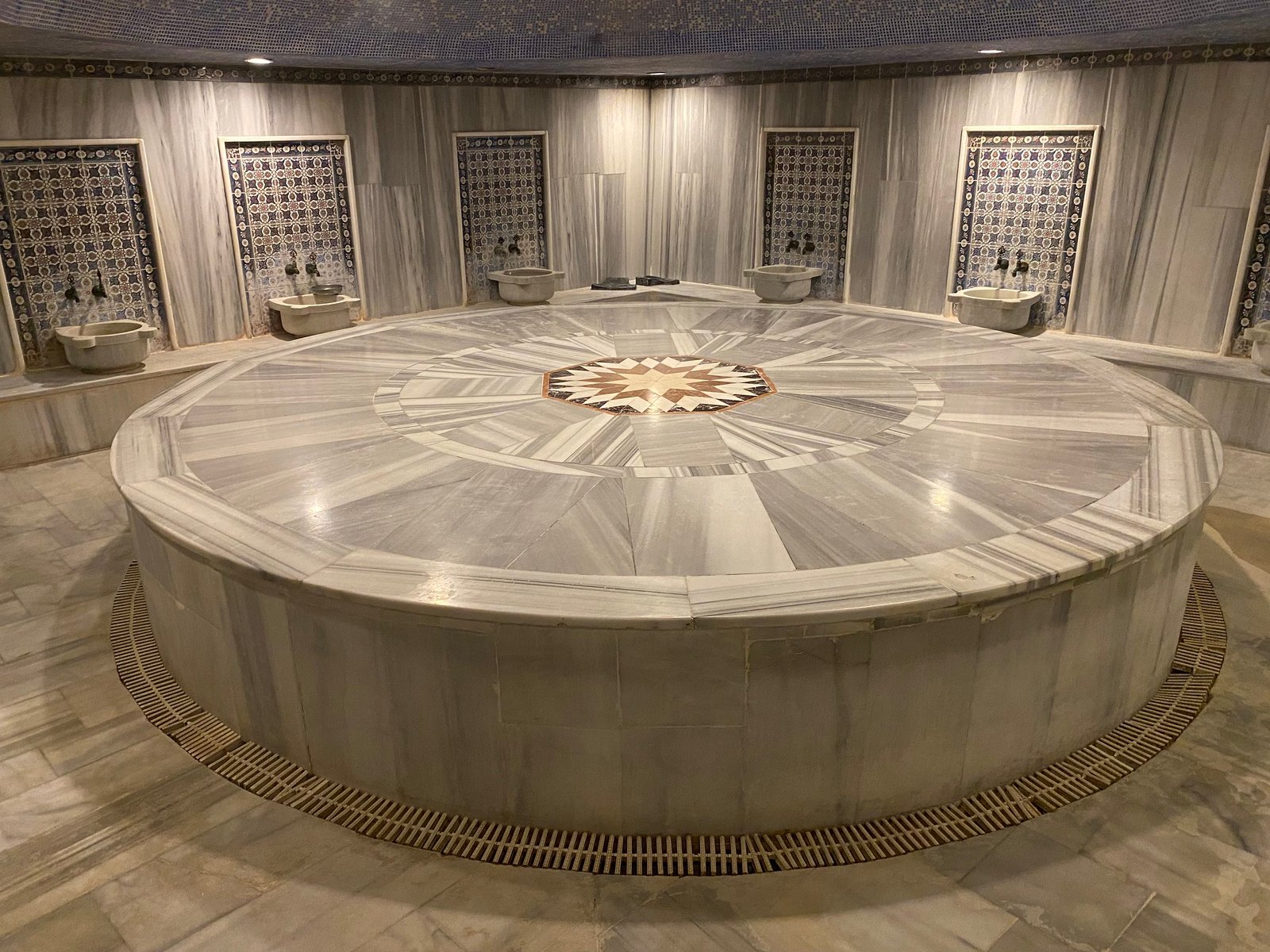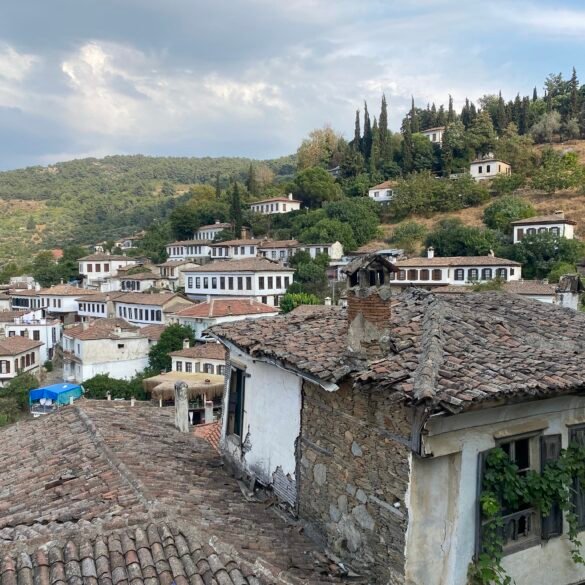My motionless body lies inside the octagon. I am on my back, in a state of total disorientation, hardly registering what is going on around me. I feel neither my legs nor arms and can barely hear any sounds. My eyes are closed, and when I squint them open, all I can see is a brightly illuminated ceiling. And I think I can see the stars in it. The man has already been working on me for a good 30 minutes and is now towering over me, slowly helping me get up. I follow him on weak legs, and a moment later, a stream of cold water hits me directly in the face. He wraps me tight in a towel, carefully walks me to the next room, sits me down, and hands me a glass of strong tea.
-So, how did you like your first Turkish hammam experience?
-Ummm…. ahhhh…. ohhhh…
I am too relaxed to say anything remotely cohesive, and simply raise a thumb up, a universal sign of approval.
***
Earlier that day, after visiting the ancient Greco-Roman town of Pergamon in the morning, we were driving towards our next AirBnB in Selcuk and had a couple of extra hours to spare. The town of Manisa was only a short detour away, and the Lonely Planet guidebook described it as home to an impressive 16th-century mosque and a Turkish bathhouse (hammam) that required advanced reservations.
Before our trip to Türkiye, we did not know anything about Manisa, but the town played an important role in Turkish history. Known in ancient times as Magnesia, during the Ottoman Empire, Manisa was a training place for future sultans. One of the sultans, Murad III, was even born and spent his childhood here, and acted as governor of the Manisa province before assuming his sultan duties. Muradiye Mosque was built on his orders. Having visited the impressive mosques of Istanbul before, we did not have lofty expectations. Can a small mosque in some provincial Turkish town compete with Istanbul’s masterpieces? Turns out, it can! Designed by Mimar Sinan, who was one of the fathers of classic Ottoman architecture, and whose apprentices later went on to design Istanbul’s Blue Mosque, Muradiye Mosque is a pure treasure. Small and intimate inside, it dazzles with an impressive mihrab wall of beautiful and colorful Iznik tiles. The colors are so intense that you start wondering whether you are in a mosque or at a Turkish spice bazaar. We sat on the floor and took in the craftsmanship and the exquisite beauty of this little jewel box of a mosque.


Right next to Muradiye Mosque was another old, but much simpler, mosque and …finally another advertised attraction, a double-domed Sultan Hammam! Despite soaking in sulfur bathhouses of Tbilisi, Japanese onsens, and Eastern European banyas, our knowledge of a Turkish hammam was very limited. Other than knowing it existed, we did not know much about what it entailed, the general layout, and the etiquette one must follow inside. And here it was! The Turkish hammam. It was the chance for us to find out what it was. But the problem was we did not have a reservation.
We decided to try our luck and dropped by to see if we could get in without an appointment. The building had two entrances on opposite sides: one for men and one for women. I approached the men’s entrance, peeked inside, and carefully asked if anyone spoke English. There were several men wrapped in towels inside, who chatted among themselves in Turkish, and then a moment later an energetic Turkish man sprang out.
-Hello! What? Reservation? No, you don’t need a reservation!! Please come in!! Where are you from? Do you want some tea?
Although we were already ready and excited for the hammam, the man nonetheless, in the best traditions of Turkish merchants, embarked on a sales pitch. He emphasized that the hammam was one of the oldest in the country, nearly 500 years old, and boasted that people come to Manisa from all over the world to experience it. He also recommended getting a VIP package for 800 Turkish liras per person (approximately, $30). We gladly agreed to buy a VIP package, whatever it was.
At this point, Julia and I separated, and Julia went to the women’s section on the other side of the building. I was ushered inside, to the general changing area, where individual changing rooms and a tea lounge were located. Men were sitting around, drinking tea, watching TV, and simply chatting, relaxing, and chilling in the lounge. One person was loudly snoring in the corner.
After I changed and left my belongings in the locker, the attendant took me to the next section of the building, where the dry sauna was located. The room was small, hot, and pleasantly smelled of timber. Nobody else was there, so I stretched out on wooden benches like a happy Istanbul cat. The attendant left me there for the next twenty minutes and when came back, he found me sweating profusely while breathing in and out hot air.
-Are you ready for the hammam? My new friend said with an intriguingly inquisitory tone, clearly building up the hype.
-Sure, let’s do it!


We then entered a large, domed room, and I stopped to savor the moment. I looked around and imagined a sultan entering this same room nearly 500 years ago after another hard day of defeating enemies and half-brothers trying to overthrow him. In the center of the room, there was a giant marble slab in the form of an octagon. The raised marble stone dominated the room, occupying more than half of the space. On each side of the wall, I noticed individual stalls, each having a wash basin and two faucets: for cold and hot water. Unlike some other newer hammams boasting elaborate decorations (of which we learned later), this room was simple, with neutral, calm greyish colors and a white ceiling with stars. The walls and ceiling also showed some noticeable wear and tear but, honestly, I neither cared nor expected a 500-year-old hammam to be sparkling new.
I was standing in front of this giant marble stone lost in the moment and trying to guess what would happen next. As I mentioned earlier, we did not know anything about the etiquette or rituals of the hammam. I imagined that at that same moment, somewhere in the women’s section, Julia was as perplexed and confused as I was. I looked at the attendant, and he motioned to the side of the marble stone. He then poured a little bit of water on it, and I laid down. The stone was pleasingly warm, and I closed my eyes, feeling the warmth flowing across my back and legs.
The man then started to cover my whole body with bubbly foam and scrub it with rough sponges. The bubbles smelled of olive oil, and the attendant was moving thoroughly from head to toe, peeling layers and layers of dead skin. This was a deep scrub. After the scrub, he washed and massaged my body to the point that I got so relaxed that I started to lose the understanding of where I was and what was happening to me. The last part of my VIP package was getting my head washed and being hosed with cold water. I absolutely loved it!
After tightly wrapping me in a towel like a burrito, the attendant walked me back to the lounge. I spent the next half an hour there in a state of total relaxation, drinking tea, and chatting with friendly Turkish men who wanted to know how we found their little town and what we generally thought of Türkiye. Julia and I soon reunited in the hammam’s courtyard to compare notes on our first Turkish hammam experience.


One week later, I met my parents at an all-inclusive hotel near Antalya. The hotel also had a sauna and hammam, and one evening, I decided to visit while Julia was getting a massage at the spa. The hammam attendant handed me a locker key and showed me the hammam and the dry sauna. No sales pitches for a VIP package were presented and I was left alone to figure out what to do next. As I spent my one and only previous visit in a state of complete and almost catatonic relaxation, I had no idea what the men who didn’t pay for someone to scrub them down actually did in the hammam. I took a shower, relaxed in the dry sauna, and then went and laid down on the marble stone in the empty hammam. As the heat from the stone radiated through my body, I relaxed all my limbs and closed my eyes.
Suddenly, I could hear footsteps coming in my direction.
“And here we have the locker rooms… dry sauna…” I heard the attendant’s voice through the hammam door.
“Looks great!” a cheerful woman’s voice exclaimed. “And what’s there?”
The footsteps got closer. It was clear they were coming towards the hammam. I froze, unsure what to do next. Is it weird that I am just lying here? Should I sit up? But sit up… and do what?
Before I could make up my mind, the door swung open and the attendant announced, “Hammam!”
In a giant empty room, I remained lying on the stone in the center of the room, my eyes closed and my body completely still.
“Umm…” The woman’s voice said, “Is that man… alive?”
I made a conscious choice to remain still and allow the attendant to explain the non-fatal properties of the Turkish hammam to this tourist. Fortunately, the door shut and I was once again left in blessed solitude to enjoy the peace and relaxation of this ancient Turkish tradition. Honestly, I am still unclear as to the etiquette and the ceremony of the hammam, but considering I left this session clean and relaxed; I think I did pretty well.
P.S. The pictures from inside of the hammam are from a hotel hammam near Antalya.

